|
|
|
| My Favourite Planet > English >
People > Medusa > part 6 |
 |
back |
Medusa – part 6 |
 |
Page 6 of 8 |
 |
|
| |
Gorgons on armour
breastplates, shields, helmets ... |
| |
 |
|
 |
A marble statue of Jupiter, the Roman equivalent of Zeus, standing, with the aegis
and a winged Gorgoneion draped over his left shoulder. To the right of the figure,
at the base of the tree trunk support, stands an eagle, a symbol of the supreme god.
Roman Imperial period, 2nd century AD. From Utica, Tunisia.
Height 175, width 60 cm, depth 40 cm.
Rijksmuseum van Oudheden, Leiden, Netherlands. Inv. No. H II BB 8.
|
|
In Greek mythology, the supreme Olympian god Zeus wore the aegis, the hide of the goat Amaltheia which had suckled him in his infancy, as armour, particularly during the Titanomachy (the war of the gods against the Titans). Homer referred to Zeus by the epithet "Aegis-Bearing" (Αἰγίοχος, Aigiochos; Latin, Jupiter Aegiochus). To this impenetrable goatskin was added the Gorgoneion, the severed head of the Gorgon Medusa, for its fearsome and deadly power. The Romans later borrowed many of the symbols of Zeus to depict their chief deity Jupiter, including the aegis and Gorgoneion, as well as other attributes such as the thunderbolt and eagle (see photo below).
In the The Iliad, Homer also mentioned that his divine children Apollo and Athena on occasions borrowed the aegis. From around the second half of the 6th century BC, during the late Archaic period, Athena was depicted wearing the aegis. The tassels (θύσανοι, thisanoi) along its fringe, which Homer wrote were made of gold, became deadly snakes like those sprouting from the Gorgon's head (see photos on Athens Acropolis gallery page 18 and Homer part 2). Although the aegis is sometimes shown being worn like a cloak or a shield over the left arm (the shield arm), from the Classical period Athena often wears it as a cuirass (breastplate), and the Gorgoneion also appears on her shield. For further information about Athena, the aegis and the Gorgoneion, see Pergamon gallery 2, page 13 and page 14.
As we have already seen (Medusa parts 1-5), the Gorgeion was used to decorate a wide variety of objects from around the beginning of the 7th century BC (see also Medusa part 7), and from at least the 6th century BC these included shields and armour.
After his death, Alexander the Great was depicted as "Alexander Aigiochos", wearing the aegis with Gorgoneion as a cape (see below), and Roman period works show him wearing a Gorgoneion on his cuirass (see below). Roman emperors were portrayed wearing a cuirass with a Gorgoneion. |

An Archaic marble relief of Athena
wearing a snake-tasseled aegis.
From the east side of the frieze
on the Siphnian Treasury, Delphi.
Circa 525 BC (see Homer part 2).
Delphi Archaeological Museum. |
| |

A silver tetradrachm coin of
Antigonos Gonatas, from
Amphipolis, Macedonia, Greece,
circa 270 BC. Helmeted Athena
wearing the aegis and holding
a shield with the Gorgoneion.
Bode Museum, Berlin. |
| |
| |
 |
|
 |
A marble statue of Jupiter Aegiochus with the aegis
and winged Gorgoneion draped over his left shoulder.
Roman Imperial period, 4th - 5th century AD. A dedication to Zeus Optimus Maximus
was later inscribed on the semi-circular base by the senator Neratius Palmatus.
Found on the Piazza dei Quinuecento, on the corner with Via Cavour, Rome.
Baths of Diocletian, National Museum of Rome. |
|
| |

A fragment of a Roman marble votive relief for Jupiter Dolichenus and Juno.
Jupiter Dolichenus (left) wears a tall tiara, a sword and a cuirass decorated with a Gorgoneion,
below which are two seated gryphons facing each other. In his raised right hand he holds a
double axe, and in the outstretched left hand a thunderbolt. To the left of his head stands an
eagle (a symbol of both Zeus and Jupiter) with a wreath in its beak. Juno stands on a stag.
In her outstretched right hand she holds a mirror, and with her left hand she holds a sceptre.
Early 3rd century AD.
Neues Museum, Berlin. Inv. No. Sk 1778.
Acquired 1921 in Rome from the Dressel Collection.
Read more about the cult of Jupiter and Juno Dolicheni on the Dioskouroi page. |
| |

An Archaic bronze statuette of Athena, with a
crested helmet, shield and brandishing a spear.
One of the earliest depictions of the goddess
wearing the Gorgoneion.
From the Sanctuary of Athena Alea, in Alea
(Tegea), Arcadia, Greece. Around 550 BC.
National Archaeological Museum, Athens.
Inv. No. 14828. |
|
|
|
| |

The "Endoios Athena", an Archaic marble
statue of seated Athena wearing the
aegis and Gorgoneion on her breast.
Around 525 BC. Attributed to Endoios.
Found in 1821 below the Erechtheion
on the North Slope of the Athens
Acropolis. Insular marble.
Height including the plinth 147 cm.
Acropolis Museum. Inv. No. Acr. 625.
Photo © Konstanze Gundudis
|
The fragmentary, badly worn figure, wearing a long chiton (tunic), is missing its head, forearms and hands, but is recognizable as Athena from the Aegis (with holes for the attachment of bronze snakes around the edge) over her shoulders and the Gorgoneion on her breast. It is earliest extant identifiable statue of Athena from Athens, perhaps depicting the goddess as Athena Ergane (Ἐργάνη, the Worker), who originally held a distaff and spindle.
It has been suggested that it may be the statue of Athena seated mentioned by Pausanias (Description of Greece, Book 1, chapter 26, section 4) as being made by Endoios and dedicated by Kallias on the Athens Acropolis.
For further details, see Endoios on the Ancient Greek artists pages. |
|
| |

A fragmentary marble statue of Athena wearing an aegis and Gorgoneion from the
west pediment of the Temple of Apollo Daphnephoros, Eretria, Euboea, central Greece.
520-490 BC, late Archaic period.
Eretria Archaeological Museum. Inv. No. MX 5.
|
Eretria (Ερέτρια) and its neighbour Chalkis (Χαλκίς) on the island of Euboea (Εὔβοια) were influential cities and pioneers in several aspects of the cultural development of ancient Greece, including the use of coinage and the Greek alphabet. Together they planted colonies around the Mediterranean. However, around 710-650 BC they waged war on each other over the Lelantine Plain which lies between them, and the protracted conflict, now known as the Lelantine War, not only drew in other Greek city states, but eventually weakened both cities. Eretria came off worse and became increasingly dominated by Athens.
The influence of Athens may be seen in the choice of subjects for the pedimental sculpture groups for the Archaic Temple of Apollo Daphephoros, Eretria's grandest temple, in the city centre next to the agora (market place) and port. The construction of the temple was begun around 520 BC, and may not have been completed by the time the invading army of the Persian king Darius I sacked the city in 490 BC. |
|
| |

Zeus on his throne gives birth to Athena.
From an Archaic Attic black-figure panel amphora, circa 540 BC, now
in the Museum of Fine Arts, Boston. See photos at perseus.tufts.edu.
|
Athena springs "fully armed", with spear and shield, from the head of Zeus. Present to assist and cheer on with music are (left - right): Hermes, Apollo, Eileithyia (goddess of birth) and Ares. Beneath Zeus' throne is a winged figure, perhaps Nike.
Apollo plays his lyre and Zeus clutches his thunderbolt. Ares carries a shield decorated with a Gorgoneion, a symbol which was also to become associated with Athena, and which she is often shown wearing on her breast.
Source: lithograph made by A. Ray for Kaeppelin & Co. Published in Elite des monuments céramographiques: matériaux pour l'histoire des religions et des moeurs de l'antiquité by Charles Lenormant (1802-1859). Leleux, Paris, 1844-1861.
In the numerous versions of this scene on ancient ceramics, various figures are shown beneath Zeus' throne. The small winged figure here has been labelled as "Sphinx", though similar vases more clearly show a winged female in human form. |
|
| |

Athena wearing the aegis and Gorgoneion, now barely recognizable,
on a fragment of an Archaistic marble relief depicting a procession
of gods from Piraeus (see the photos on the Hermes page).
Piraeus Archaeological Museum. Inv. No. 2087. |
| |

Athena wearing the aegis with a Gorgoneion and a fringe of snakes on
the "Athena Farnese", a restored Roman period marble statue thought
to be a copy of the Classical Greek bronze original by Pyrrhos, which
was set up by Pericles on the Athens Acropolis.
National Archaeological Museum, Naples. Inv. No. 6024. Albani Collection.
See Athens Acropolis gallery page 10. |
| |

The Gorgoneion and fringe of snakes on the aegis of the "Athena Farnese". |
| |

Detail of a marble statue of Athena wearing a Corinthian helmet,
with the aegis and a winged Gorgoneion on her breast.
2nd century AD.
National Archaeological Museum, Naples. Inv. No. 6321. Farnese Collection. |
| |
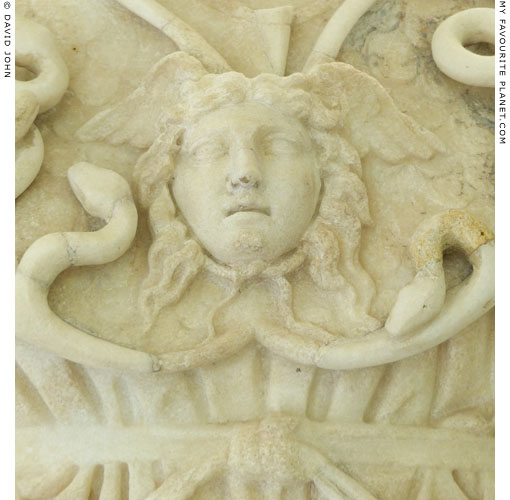
The Gorgoneion and snakes of the aegis on the statue of Athena above. |
| |

The Gorgoneion in the centre of an Amazonomachy relief on the "Strangford Shield",
a fragment of a marble replica of the shield of Athena Parthenos.
From Athens, 3rd century AD.
British Museum. GR 1864.2-20.18 (Sculpture 302). Strangford Collection.
|
The fragment was acquired in Athens by the British politician Percy Clinton Sydney Smythe, 6th Viscount Strangford (1780-1855), one of the antiquities he collected while British ambassador to Ottoman Turkey, 1820-1824. It was purchased by the British Museum in 1864 from Percy Smythe, the 8th Viscount Strangford.
During the Roman period many copies were made of the colossal chryselephantine (gold and ivory) statue of Athena Parthenos by Pheidias, which stood in the Parthenon on the Athenian Acropolis. The "Strangford Shield" is the only surviving part of one of these replicas (see two smaller replicas: the "Athena Lenormant" statuette and the "Varvakeion statuette" on Athens Acropolis gallery page 13). Traces of the original paint have survived. Only the front of this shield has a relief, the back is blank. Ancient authors indicate that the outside of the original shield showed an Amazonomachy (battle between Greeks and Amazons), and the inside a Gigantomachy (battle between gods and the Giants).
According to Plutarch (Life of Pericles, 13), Pheidias was accused by enemies of Pericles of stealing gold intended for the Athena Parthenos statue, and of impiety for portraying Pericles and himself among the figures of the Amazonomachy on the statue's shield. On this replica, Pheidias and Pericles are thought to be the two men standing back-to-back below the Gorgoneion: Pheidias is the balding, naked figure on the left with an axe in his raised arms; Pericles stands to his right, wearing a helmet and armour, his left foot resting on a fallen Amazon, his right arm raised and obscuring his face. Having been warned by Pericles to carefully weigh the gold, Pheidias was able to disprove the charge of theft, but he was found guilty of impiety, and died while in prison. |
|
| |

Winged, baby-faced head of Medusa on the shield
of the "Varvakeion statuette", a small replica of
the Athena Parthenos statue by Pheidias.
From Athens, 3rd century AD.
(See Athens Acropolis gallery page 13)
National Archaeological Museum, Athens. Inv. No. 129. |
| |

A reconstructed marble statue of Athena wearing
the aegis and Gorgoneion. It covers her right breast,
and is tied at the right shoulder and above the waist
on her left side.
Roman Imperial period. Late 1st century AD. Height
with restored head 209 cm, width 72 cm, depth 59 cm.
One of two almost identical Roman period, reconstructed
marble statues of Athena in the Albertinum, Dresden
(the other Inv. No. Hm 049) controversially identified
by the German archaeologist Adolf Furtwängler as copies
of the bronze "Athena Lemnia" statue by Pheidias
(450-440 BC) from the Athens Acropolis, mentioned by
Pausanias as "the best worth seeing of all the works
of Phidias" (Description of Greece, Book 1, chapter 28,
section 2) and Lucian (Imagines, 4 and 6).
Skulpturensammlung, Albertinum, Dresden.
Replica B. Inv. No. Hm 050. |
|

High relief of Athena wearing the
aegis and Gorgoneion on her breast.
From the theatre of the Lower City,
Pergamon. Marble. Roman period.
Bergama Archaeological Museum. |
|
| |
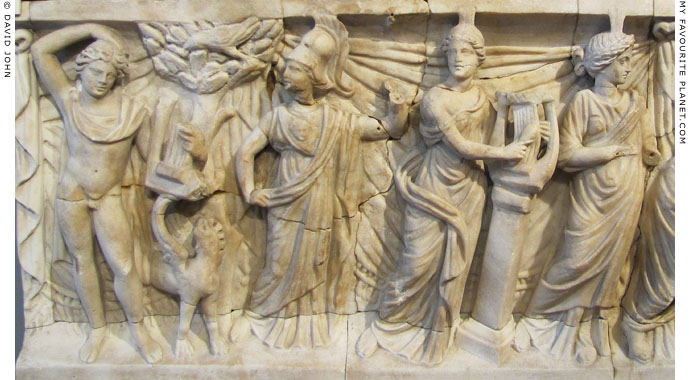
Detail of a relief on the front panel of a restored Roman marble
sarcophagus depicting Apollo, Athena/Minerva and the nine Muses.
Left: Apollo of the Lykeios type with kithara and griffin.
A crow or raven stands in a tree to the right of his head.
Centre: Athena wearing a Corinthian helmet
and the aegis and Gorgoneion on her breast.
Right: Two Muses, one playing a kithara with a plectrum.
From the Via Appia, Rome, around 200 AD. The Latin inscription on the
sarcophagus lid states that Ulpia Eutychia dedicated it to her parents.
Altes Museum. Berlin. Inv. No. Sk 844. |
| |

Athena wearing the aegis and Gorgoneion on an Etruscan ceramic high relief
depicting two episodes from the Greek myth of The Seven against Thebes.
From the rear pediment of Temple A of the sanctuary of the Etruscan goddess
Uni (equivalent of the Roman goddess Juno, Greek Hera and Phoenician
Astarte) at Pyrgi, the port of Caere (today Cerveteri), Latium. 470-460 BC.
National Etruscan Museum, Villa Giulia, Rome. |
| |

Bronze statuette of the Etruscan goddess
Menvra, modelled on Greek figures of Pallas
Athena, or Palladion, with raised spear and
shield and wearing the aegis in the form
of a short poncho-like cape. The helmet,
similar in form to the Attic helmet on Greek
copies of the Athena Parthenos statue
by Pheidias, is shown with the cheek flaps
raised. Unusually, the goddess is barefoot,
lacking the usual sandals.
From Apiro, Italy. 4th century BC.
Height 24.3 cm.
Altes Museum, Berlin. Inv. No. Fr. 2176.
Acquired from the Bartholdy Collection. |
|

Bronze statuette of Menvra wearing
the aegis and Gorgoneion. The head
of the Gorgon is as large as that of
the goddess. Her right rather than
left leg is bent. The handle in her
left hand and spigot on the forearm
indicate where a shield was
attached to the figure.
From central Italy. Circa 500 BC.
Altes Museum, Berlin. Inv. No. Fr. 2178.
Acquired from the Dorow Collection. |
|
| |
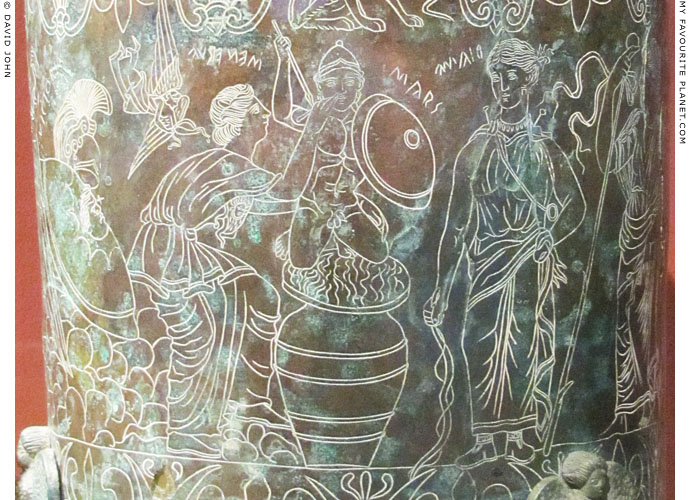
Minerva (here inscribed Menerva), the Roman equivalent Athena and the Etruscan
Menvra, wearing the aegis and Gorgoneion on the side of a cylindrical bronze
cista with an engraved depiction of a myth concerning the war god Mars (centre).
The names of the participating deities are inscribed in Latin. A round shield with
a Gorgoneion and a crested helmet lie on rocks to the left of Minerva.
4th century BC. From Praeneste, Latium, Italy.
Altes Museum, Berlin. Inv. No. Fr. 2178. Acquired in Rome in 1873. |
| |

A cast bronze roundel of Athena Promachos, wearing a sleeveless peplos, fastened
at the right shoulder with a round fibula, a helmet in the form of Medusa's head,
and the aegis with a snake on the border over her left shoulder. Her right
arm is raised as if about to throw a spear, as in statues of Athena Promachos.
A decoration from a formal chariot used for parades, perhaps belonging to a wealthy
hetairos (royal officer) or a member of the Macedonian royal family. Possibly from
a workshop in Delos. Hellenistic, first half of the 2nd century BC. Diameter 27 cm.
Excavated on Kyprion Agoniston Square, Thessaloniki, during a rescue dig
in a Hellenistic public building, possibly the palace of the Macedonian kings.
Thessaloniki Archaeological Museum. Inv. No. 17540. |
| |
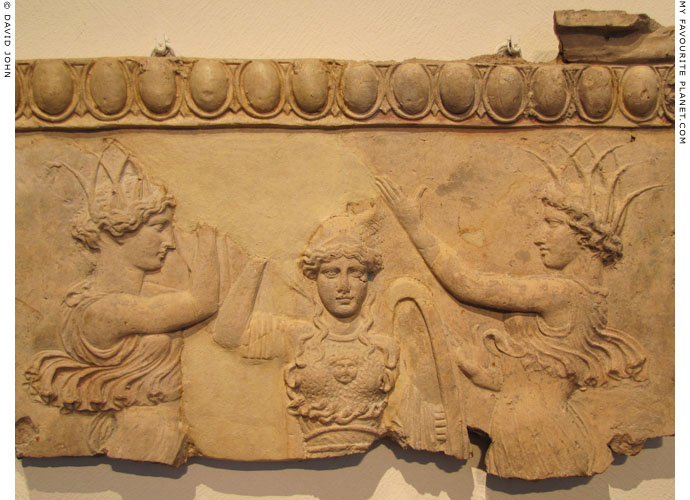
Female dancers around Palladion, 1-50 AD.
Athena/Minerva in the pose of Palladion with holding a shield and a raised spear (most of
which is now missing), wearing a helmet, and the aegis with a Gorgoneion on her breast.
A "Campana plaque": colourfully painted ceramic reliefs depicting scenes from mythology
and daily life which decorated the interior and exterior walls of sacred, public and private
buildings from the mid 1st century BC until the first half of the 2nd century AD. [1]
"But there came a phantom, as it seemed to us onlookers,
of Pallas, with plumed helm, brandishing a spear."
Euripides, Heracles, lines 1002-1003.
Altes Museum, Berlin. Inv. No. TC 559. Acquired in 1696 from the Bellori Collection. |
| |
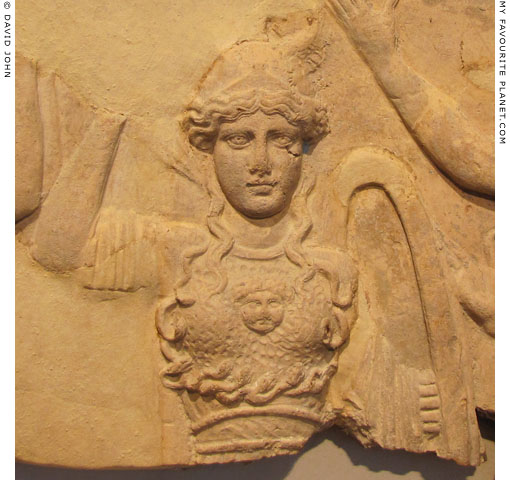
Palladion wearing the aegis and Gorgoneion on the Campana plaque above. |
| |
 |
|
 |
A marble bust of Athena emerging from a flower, wearing an Attic
helmet, the aegis fringed with snakes, and a winged Gorgoneion.
Roman Imperial period.
Eleusis Archaeological Museum. |
|
| |

The Gorgoneion on a repoussé (hammered) and cut out bronze shield device.
Made in a Peloponnesian or Ionian workshop, first half of the
6th century BC. Excavated at the Sanctuary of Zeus, Olympia.
Olympia Archaeological Museum. Inv. No. B 110.
Currently exhibited in the Museum of the History
of the Olympic Games in Antiquity, Olympia.
|
| Medusa's head, with eyes of inlaid bone and surrounded by writhing snakes, is set in a medallion (see photo below), around which are three swirling, sickle-shaped wings. The arrangement of the wings is reminiscent of the triskelion (τρισκέλιον), the ancient three-legged symbol, particularly associated with Sicily and Greek cities in Anatolia (Asia Minor) such as Aspendos, which is often depicted with a Gorgoneion in the centre. |
|
| |

Detail of the Gorgoneion medallion on the bronze shield device above. |
| |

The Gorgoneion on a repoussé (hammered) and cut out,
round, bronze shield device (ἐπίσημον, episemon).
Probably made in a workshop in East Greece (Ionia and the eastern Aegean islands),
perhaps in Samos, around 650-600 BC. Excavated at the Sanctuary of Zeus, Olympia.
Olympia Archaeological Museum. Inv. No. B 4772.
Currently exhibited in the Museum of the History
of the Olympic Games in Antiquity, Olympia.
|
All around the head are protomes (heads) of snakes, and around the disc, on the eyebrow and top of the nose are holes for attaching the device to a shield. The eye sockets probably contained inlaid eyes. According the museum label the forehead is "decorated with incised anthemia and foliate ornaments", although only two rosettes, on the right ear lobe and immediately to the right of it, are visible.
The device was originally affixed to the outside of a round wooden shield (ἀσπίς, aspis, or ὅπλον, hoplon). Such shields, other items of armour and weapons, often captured from defeated enemies, were brought to the sanctuary of Zeus at Olympia as thanks offerings to the god and other deities worshipped there.
See other depictions of shield devices in Greek art in Homer part 2. |
|

A fragment of a black-figure vase with
a depiction of three warriors carrying
round shields decorated with devices,
and four-horse chariots.
750-700 BC. From Kerameikos, Athens.
Kerameikos Archaeological Museum. |
|
| |

A winged Gorgon on a repoussé (hammered) and cut out bronze shield device.
Made in a workshop in Magna Graecia (southern Italy), second
half of the 6th century BC. From Olympia, Peloponnese, Greece.
Olympia Archaeological Museum. Inv. No. B 4490.
Currently exhibited in the Museum of the History
of the Olympic Games in Antiquity, Olympia.
|
The Gorgon wears a transverse crest with two long tails falling to either side of her torso (see a depiction of a helmet with a transverse crest below). She has a fringe of small snakes and inlaid eyes, and grasps two larger snakes which rise from her belt (see photo below). Her torso is scaly, and her wings, shown in front of her arms, appear to grow out her breast. Below the waist she has attributes of a monster (referred to by some archaeologists as a dragon), the tail and fins of a fish and the running front legs of a lion.
A unique depiction of a Gorgon of exceptionally fine workmanship. The round shield used as a background is a modern reconstruction which includes ancient bronze fragments found with the device. |
|
| |

Detail of the winged Gorgon on the shield device above. |
| |

A relief of a Corinthian helmet with a double-tailed transverse crest,
on the finial (ornamental top stone) of a three-sided funerary stele,
probably a war memorial. The names of fallen soldiers may have
been inscribed on the body of the stele, below the rosettes.
Second half of the 4th century BC.
From Aegaleo (Αιγάλεω), Attica, Greece.
Piraeus Archaeological Museum. Inv. No. 2575.
|
Helmet crests or plumes are often mentioned in ancient literature and shown in Greek art, particularly on pottery (see several photos in Homer part 2, including examples from as early as the 7th century BC), but there appears to be little archaeological evidence for their use on surviving Corinthian helmets. They are thought to have been made of long horse hairs, presumably from the mane or tail, gathered as a brush in a curved frame (like the ferrule of a paintbrush) of metal, wood or other materials, and affixed to the top of the helmet with nails, rivets, twine, pitch or some other adhesive.
The type most usually depicted is known as a longitudinal crest (see photos below), running from front to back along the top of the helmet, with a long tail falling at the rear. Depictions of Greek transverse crests, running from side to side (why not lateral or latitudinal?), are rare, usually worn by gods or heroes in mythological contexts. According to one modern theory, they were originally worn only by high-ranking Spartan officers, but their use became more popular in the rest of the Greek world around the mid 5th century BC. It is known that later some Roman helmets had transverse crests, but the extent of their use by Greek soldiers remains a matter of debate.
Closed Corinthian helmets of the type shown on all three sides of the finial above were probably no longer used in the second half of the 4th century BC. The crest is enormous, and the long tails end in spirals which merge with the anthemions and palmettes at the corners of the frieze. On another side the crest is topped by two large confronting gryphons (see photo right). Altogether the helmets appear impractical for battle armour, although some items of parade or ceremonial armour had fanciful ornamental designs. The composition is more likely a decorative fantasy with mythological or legendary connotations, rather than a representation of a helmet worn by a contemporary soldier. |
|

The gryphons on a transverse helmet
crest on another side of the finial. |
|
| |
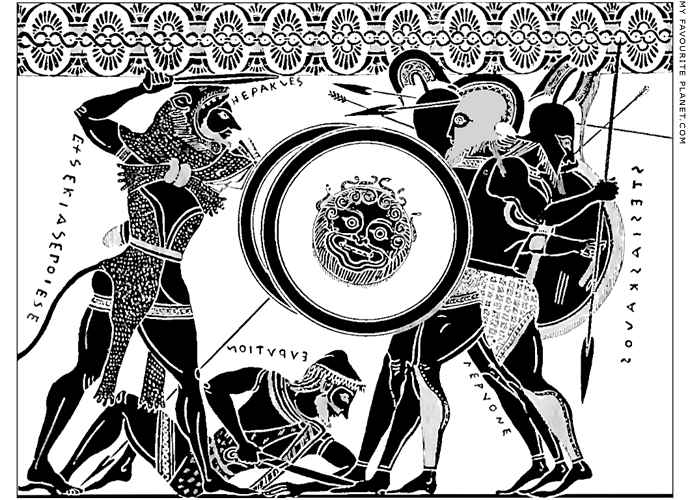
Herakles fighting the triple-bodied monster Geryon. One of the Twelve Labours of Herakles.
The panel of an inscribed Attic black-figure belly amphora, signed by Exekias as
potter, Έχσηκίας έποίεσε (Exsekias epoiese, Exekias made it), behind Herakles.
Painted by a member of Group E. Circa 530 BC. From Vulci, Etruria (Lazio, Italy).
On each of his three heads Geryon wears a Corinthian helmet with a crest, two of which
are set high. He has greaves on his six legs, carries three spears and a corselet appears
to cover his united torso. A hypnotic Gorgoneion device can be seen on one of his three
round shields, but it will not save him from Herakles determined attack - the hero will
always find victory - and two arrows from his bow have already found their target.
Louvre Museum, Paris. Inv. No. F 53.
Image source: Olivier Rayet and Maxime Collignon, Histoire de la
céramique grecque, fig. 55, page 117. Georges Decaux, Paris, 1888. |
| |

Ajax preparing for his suicide on the panel on side A of an Attic
black-figure neck amphora painted by Exekias, around 530-525 BC.
The naked Greek hero plants the hilt of his sword in a mound of earth. On the left stands
a palm tree and to the right his armour, a spear, a Corinthian helmet and a shield decorated
with the head of a lioness (or panther) over a Gorgoneion. The scene is unique in ancient
Greek art, since other depictions of this incident show Ajax falling on his sword or stabbing
himself rather than preparing for his death (see Homer part 2).
Musée des Beaux-Arts et d'Archéologie, Boulogne, France. Inv. No. 558.
Image source: Ernst Pfuhl, Malerei und Zeichnung der Griechen. Munich, 1923. |
| |

The centre of an Attic black-figure plate painted by the Athenian vase painter Psiax,
540-510 BC, depicting a warrior. Found in the Sanctuary of Zeus at Olympia, Greece.
The bearded warrior, wearing an Attic helmet with a longitudinal crest, a short-
sleeved chiton (tunic), cuirass and greaves, strides to the left. In his right hand
he holds his spear at head height, with the front pointed downwards. With his
left arm he carries a Boeotian shield decorated with an aegis and Gorgoneion.
Altes Museum, Berlin. Inv. No. F 2099.
Beazley Archive Database, Vase No. 320364. |
| |

The Gorgoneion on the round shield of an Achaean (Greek) warrior, perhaps Achilles
or Menelaos, on a high relief depicting a battle with Trojans during the Trojan War.
Detail of the Archaic marble relief from the east side of the frieze of the Siphnian Treasury
in Delphi, built for the people of Siphnos (Σίφνος) around 530-525 BC. Parian marble.
Delphi Archaeological Museum, Greece.
For further information about the east frieze
of the Siphnian Treasury, see Homer part 2. |
| |

Thetis hands the armour made by Hephaistos to
her son Achilles during the siege of Troy. The shield
is decorated with a Gorgoneion and a lion's head.
The front panel of the Monteleone Chariot.
Around 575-550 BC. Bronze with ivory inlays.
Metropolitan Museum of Art, New York. Inv. No. 03.23.1.
|
The Monteleone Chariot was discovered in 1902 in an underground Etruscan tomb by Isidoro Vannozzi, a landowner at Monteleone di Spoleto, in the province of Perugia, southeast Umbria, Italy. He also found bronze, iron and ceramic grave goods in the tomb, and the artefacts were sold on to various dealers and collectors. The chariot ended up on the art market in Paris, where it was purchased in 1903 from O. Vitalini by General Luigi Palma di Cesnola, the first director of The Metropolitan Museum of Art.
The Etruscan parade chariot has three panels made of bronze inlaid with ivory. The front panel is much larger than those on either side; all three are decorated with reliefs thought to depict episodes from the life of Achilles.
The front panel (photo above) shows the veiled Thetis, on the left, facing a bearded Achilles, with both figures in profile. They hold a Corinthian helmet with a crest supported by a ram's head, and a large shield decorated with a Gorgoneion above a lion's head. Below the shield is the body of a deer on its back, and above the head of each figure a flying bird of prey descends vertically, head down.
The panel on the left side of the chariot (see image below) depicts a duel between two warriors, perhaps Achilles and the Trojan Memnon, both standing in profile over the body of a fallen warrior. Both warriors wear crested Corinthian helmets and greaves, with a spear raised in one arm and holding a shield in the other. The figure on the left has a round shield, while the shield of the figure on the right is similar to that given to Achilles on the front panel, although here the lion's head is above that of the Gorgon.
The right-hand panel depicts the the apotheosis of Achilles, with the hero ascending in a chariot drawn by winged horses. Other reliefs, over the wheels, are thought to depict Achilles as a youth with his mentor, the centaur Cheiron (see Homer part 2), and Achilles as a lion killing his enemies depicted as a stag and a bull.
See: metmuseum.org/art/collection/search/247020
Source of images: Woldemar Graf Uxkull-Gyllenband, Archaische Plastik der Griechen, Band 3, Abbildungen 21 (above), 22 (below). Verlag Ernst Wasmuth, Berlin, 1920. |
|
| |

The bronze panel on the left side of Monteleone Chariot, depicting a duel between
two warriors, perhaps Achilles and the Trojan Memnon, both standing in profile over
the body of a fallen warrior. Both warriors wear crested Corinthian helmets and
greaves, with a spear raised in one arm and holding a shield in the other. The figure
on the left has a round shield, while the shield of the figure on the right is similar
to that given to Achilles on the front panel of the chariot (see above), although
here the lion's head is above that of the Gorgon. |
| |

A Gorgoneion in negative relief in the centre of an inscribed limestone model for a shield.
Around 335-250 BC, Ptolemaic period. From Memphis, Egypt. Diameter 70 cm.
Allard Pierson Museum, Amsterdam. Inv. No. 7879.
|
Made during the reign of Ptolemy I Soter (Πτολεμαῖος Α' Σωτήρ, Ptolemy I Savior, ruled 323-285 BC) or his son and successor Ptolemy II Philadelphus (Πτολεμαῖος Β' Φιλάδελφος, Ptolemy II Sibling-Lover, ruled 285-246 BC), later known as Ptolemy the Great.
Purchased in 1902 from an art dealer in Cairo. Discovered together with life-size Ptolemaic models of helmets and a cheek-piece, probably from the workshop of an armourer, working in either leather or bronze. The name Ptolemaios is inscribed in the band around the Gorgoneion, written retrograde (right to left), in this case anti-clockwise:
ΠΤΟΛΕΜΑΙΟΥ (PTOLEMAIOU, of Ptolemaios)
Surrounding the Gorgoneion and inscription are seven peltai (from the Greek πέλτη, shield), each consisting of three parallel, crescent-shaped lines and an eight-pointed star with a dotted centre. On the other side of the shield is a central six-pointed sunburst or starburst device. This is not visible, since the object is displayed at the back of a crowded glass cabinet,
behind an unrelated marble statuette of an unknown Ptolemaic king as pharaoh. [2] A similar shield design can be seen on Macedonian "shield coins" of around the same period, for example a silver tetradrachm of Antigonus II Gonatas (circa 319-239 BC) with the head of Pan in the centre (see the Pan page).
A similar round Macedonian shield (without a Gorgoneion) is shown on a marble relief of a battle scene on the Aemilius Paullus Monument at Delphi (around 168 BC).
Catalogue No. 252, pages 187-189, plate 88, a-b. In the museum catalogue it is noted that both types of decoration on this shield model also appear on painted shields on the north and south walls of the Macedonian Tomb of Lyson and Kallikles at Lefkadia (circa 200 BC).
Read more about the museum's catalogue of ancient sculpture on the Alexander the Great page. |
|
| |

Detail of the Gorgoneion on the shield model from Memphis.
She looks more stunned than stunning. |
| |

A bronze guard for a right upper arm, with a
repoussé (hammered) and incised Gorgoneion
with inlaid bone eyes on the shoulder.
Made in Magna Graecia (southern Italy)
around 550-500 BC. Found during excavations
on the north embankment of the stadium
in Olympia, Peloponnese, Greece.
Olympia Archaeological Museum. Inv. No. B 4880.
Currently exhibited in the Museum of the History
of the Olympic Games in Antiquity, Olympia. |
|
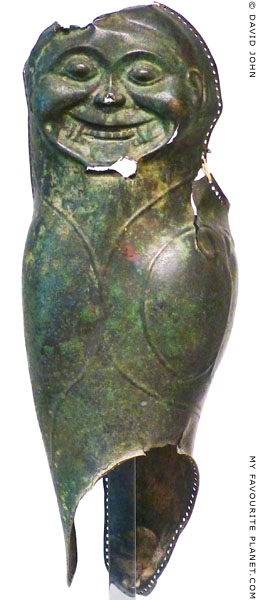
A bronze vambrace, armour for a right
arm, with a Gorgoneion on the shoulder.
Around 550 BC. From Olympia, Greece.
A votive offering, probably war booty.
Altes Museum, Berlin. Inv. No. Misc. 6402.
Acquired from the Komnos Collection, 1874. |
|
| |

Detail of a greave (leg armour) from a bronze statue
of a mounted warrior, with the head of a pretty,
jolly-looking Gorgon on the knee.
Made in Taranto, southern Italy, around 470-450 BC.
British Museum. Inv. No. GR 1886.3-24.1 (Bronze 265).
Barone and Piot collections. |
| |
 |
 |
Bronze pilos helmet decorated with a Gorgoneion attachment.
Beaten cast bronze. 4th century BC. Provenance unknown.
Greek section, Civic Archaeological Museum, Milan. Inv. No. A 987.05.03.
|
|
The Gorgoneion is one of four attachments which originally decorated the sides of the helmet.
A pilos (πῖλος, felt; Latin, pileus, pilleus or pilleum) was a conical cap, made of felt or leather, often shown worn by men in ancient Greek and Roman art, particularly in depictions of the Dioskouroi, Hephaistos and Odysseus. It is thought that the pilos helmet was developed from the hat in Sparta in the 5th century BC. During the same century the helmet became popular among infantry soldiers in other Greek city states. An Attic funerary stele of around 410 BC shows two Athenian soldiers wearing pilos helmets (see Thucydides). A marble funerary relief from Pella, Macedonia, dated 430-420 BC, depicts a soldier wearing a pilos (see Pella gallery page 18).
Many of the artefacts in the Milan museum were donated or purchased from various private collections, and their provenance is unknown. |
|
| |
 |
|
 |
A not-so-hideous Gorgoneion on the aeigis of a marble statue, perhaps
depicting a Roman emperor, now headless and unidentifiable. The work
is a replica of a Hellenistic statue of Alexander the Great, known as the
"Alexander Aigiochos", which was probably from Alexandria, Egypt.
Made during the reign of Emperor Hadrian, 117-138 AD.
Found at 32 Karaoli-Dimitriou Street, Thessaloniki.
Thessaloniki Archaeological Museum. Inv. No. ΜΘ 21996. |
|
| |

Alexander the Great wearing the Gorgoneion on the breastplate of his linothorax
(armour made of layered and stiffened linen). Detail of the "Alexander Mosaic"
depicting Alexander fighting the Persian king Darius III at either the Battle of Issos
in 333 BC or the Battle of Gaugamela in 331 BC. Thought to be based on a lost painting.
Floor mosaic, made using the opus vermiculatum (Latin, worm-like work) technique of local
stone and some glass tesserae. 125-120 BC. Found in the House of the Faun, Pompeii.
National Archaeological Museum, Naples. Inv. No. 10020.
See more photos and information about this mosaic on
the Alexander the Great page of the MFP People section. |
| |
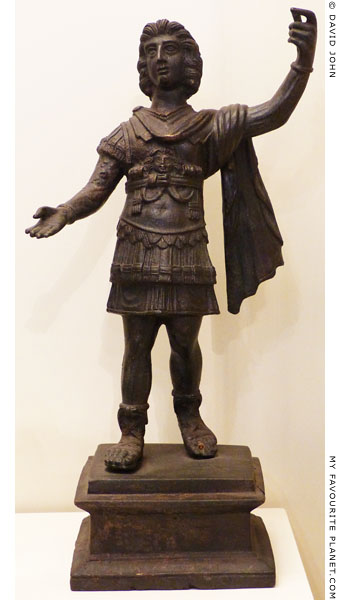
Copper alloy statuette from Egypt depicting
Alexander the Great as a Roman general,
wearing the Gorgoneion on his cuirass.
National Archaeological Museum, Athens.
Egyptian Collection, Inv. No. 2577. |
| |
 |
 |
Marble bust from a statue of Emperor Claudius (reigned
41-54 AD) wearing a cuirass with the Gorgoneion.
From Nikomedia (Izmit, Turkey). 1st century AD.
Istanbul Archaeological Museum. Inv. No. 87 T. |
|
| |
 |
 |
Detail of a marble statue of Emperor Hadrian (reigned
117-138 AD) wearing a cuirass with the Gorgoneion.
From the agora of Thasos, Greece. 130 AD.
Thasos Archaeological Museum. |
|
| |

A marble bust of Emperor Hadrian wearing a cuirass decorated
with a rather masculine Gorgoneion. An imago clipeata, a portrait
in a round frame, resembling a shield (Latin, clipeus).
From Thespiai (Θεσπιαί), Boeotia, central Greece. Mid 2nd century AD.
Thebes Archaeological Museum.
|
The original architectural context of this clipeus is unclear, and the guide to the Thebes museum merely states that it "had perhaps been boxed into a wall". The reverse side of the clipeus depicts a snake, a symbol of Asklepios (see photo on the Asklepios page), probably a reference to the Asklepieion at Thespiai. The fact that it was sculpted on both sides suggests that it was designed for a free-standing monument, perhaps a propylon (gateway).
Hadrian visited Thespiai during his stay in Boeotia in 125 AD. While there he is said to gone hunting, and an inscribed epigram records that he dedicated a boar he had killed to Eros at the god's sanctuary in the city (inscription IG VII 1828). It has recently been suggested that the dedication was intended for his deceased favourite Antinous in the guise of Eros.
Unusually, the excellent new museum displays the clipeus in a metal frame suspended from the ceiling, high above the other exhibits. Thankfully, It is the only artefact in the museum to be displayed in this peculiar manner. A strange design decision, perhaps to save space or as a piece of exhibition showmanship. The reason usually given by museums for the recent trend of placing some exhibits so high (as well as that of displaying floor mosics horizontally rather than on a wall) is that it is meant to give visitors an impression of how they originally appeared to ancient viewers. Many of us would rather be able to see an exhibit than merely have an impression of it.
See also an imago clipeata of Marcus Arelius in Eleusis below. |
|
| |
 |

Jolly-looking Gorgon on the
breastplate of the statue
of Marcus Aurelius. |
Detail of a marble statue of Emperor Marcus Aurelius (joint
emperor 161-180 AD) wearing a cuirass with the Gorgoneion.
From Italy. The head and body of the much restored sculpture are from
separate statues. The body, 50-80 AD, was found near Tivoli. The head,
of the second type of portrait of Marcus Aurelius, is dated to 150 AD.
Altes Museum, Berlin. Inv. No. Sk 368. Acquired in 1761. |
|
| |

A marble imago clipeata with a bust, believed to be a portrait of Emperor Marcus Aurelius,
wearing a cuirass (breastplate) with a Gorgoneion. Around 170-180 AD. From the pediment
of the Greater Propylaia of the Sanctuary of Demeter and Persephone in Eleusis, which was
probably built or completed by Marcus Aurelius, who is thought to have been initiated into
the Eleusinian Mysteries by Herodus Atticus around 176 AD. The Gorgoneion has been
defaced by a carved Christian crucifix.
The relief figure of a "giant" on the right shoulder strap is very similar (not identical)
to that on a bust of Marcus Aurelius found near Marathon and now in the Louvre
(Inv. No. Ma 1161) [3], and is thought to symbolize the Germanic Marcomani,
who the emperor defeated in 172/173 AD.
Eleusis Archaeological site. |
| |

A headless marble portrait bust, probably of Emperor Marcus Aurelius or his
adoptive brother and co-emperor Lucius Verus (reigned 161-169 AD), wearing
a cuirass decorated with a Gorgoneion, whose eyes are covered by a cloak.
From the Samothrakeion, Delos. Mid 2nd century AD.
Delos Archaeological Museum. Inv. No. A 7779.
|
| Unusually, the deadly gaze of the Gorgon has been covered by the cloak. To the modern viewer, at least, an apparent touch of humour, but perhaps a subtle piece of propaganda, meant to broadcast the emperor's mercifulness or benevolence towards his subjects on Delos. The Gorgoneions on the busts of Marcus Aurelius and Lucius Verus found near Marathon [see note 3] have been treated in the same way. |
|
| |
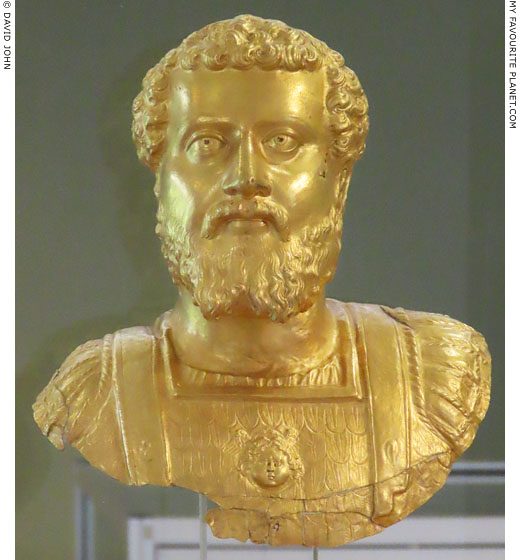
A gold bust of the Roman emperor Septimius Severus (145-211 AD;
reigned 193-211 AD) wearing a cuirass of the type Lorica plumata (Greek
in origin), decorated with a Gorgoneion and aegis (see detail below).
Circa 194-197 AD, Roman Imperial period. Height 28.4 cm, width 25.5 cm.
Smaller than lifesize. Weight 980 grams, 23 carats. Thickness of the metal
sheet approximately 1 - 1.4 mm. Discovered by chance in June 1965 at
Didymoteicho, Thrace, northeastern Greece, believed to be the location
of ancient Plotinopolis.
Komotini Archaeological Museum. Inv. No. ΑΓΚ 207.
|
Plotinopolis (Πλωτινούπολις or Πλωτινοπολις) is thought to have been originally a Thracian then Hellenistic settlement (perhaps named Kerselenos) that stood at what is now the Greek town Didymoteicho (Διδυμότειχο), on the Erythropotamos River (Ερυθροπόταμος), near where it flows into the Hebros River (Έβρος; pronounced Evros in modern Greek), which today forms the border between Greece and Turkey. It is believed that the town was destroyed by the Romans in 204 BC, during their conquest of Macedonia and Thrace. Emperor Trajan (53-117 AD; reigned 98-117 AD) refounded it as a Roman city and renamed after his wife, Pompeia Plotina (empress 98-117 AD; died 121/122 AD). Plotina, a highly educated woman, became a friend and ally of Trajan's adopted heir and successor Hadrian.
In the 6th century AD Byzantine emperor Justinian I (reigned 527-565 AD) restored fortifications on the two hills above the river, Kastro (Το Κάστρο, Castle; also known as Kale, its name in Turkish) and the lower Agia Petra (Αγία Πέτρα), thought to be the site of Plotinopolis. The fortified hills became known as Didymoteicho (which means Twin Fortifications). From the end of the 7th century, Agia Petra was abandoned, and the city continued to develop within the walls on Kastro hill.
First conquered by the Ottoman Turks in 1359, Didymoteicho became their first capital in Europe in 1361, before they took Adrianople (today Edirne) in 1366 and then Constantinople (Istanbul) in 1453. The city officially became a part of the modern Greek state following the Treaty of Sèvres in July 1920.
There are now few remains of the ancient city to be seen and archaeological investigations there have been few and sporadic. Most recently, discoveries made during locally-financed excavations between 2007 and 2013 included a richly decorated mosaic floor of a baths, around 130 square metres in area, from the late 2nd to early 3rd century AD. Among the many fabulous and mythological figures depicted in the mosaic are Apollo, the Muses, Eros riding a dolphin and a Nereid.
The golden bust of Emperor Septimius Severus was discovered by chance on the east slope of Agia Petra hill in early June 1965, unearthed at a depth of around 1.6 metres by Greek soldiers digging a trench (or tunnel). The bust was in remarkably good condition, apart from damage to the left cheek, probably caused by the digging tool of one of the soldiers. Keeping their discovery secret, they hid the bust, and cut off part of the lower edge of the cuirass which they sold in pieces for its value in gold. Although there appear to be no official reports available on the matter, it seems that they were denounced to officials and a few days later the bust was rescued from being melted down. Consequently, Greek archaeologist Andreas Vavritsas (Ανδρεας Βαβρίτσας) carried out excavations in the area where the bust was found, but once again little information on his work appears to have been made public.
At the time of the bust's discovery, scholars debated the identity of the portrayed person, with some suggesting Emperor Marcus Aurelius. In 1968 Anna Marguerite McCann was the first to correctly identify it as a portrait of the Libyan-born emperor Septimius Severus, despite having never seen it, and only having access to a single, poor-quality photo. It would take until 2017 before the first comprehensive study of the bust was published by Anne de Pury-Gysel, who had careully examined it and other Roman imperial busts.
It is thought that the bust may have been displayed on top of a long pole like a military standard, perhaps carried during processions, parades or ceremonies by an imaginifer, a Roman officer responsible for carrying the emperor's portrait (imago militaris).
This portrait bust has been compared to a slightly larger-than-lifesize marble bust of Septimius Severus (Soechting type 1), found in Thessaloniki (see photo, above right). [4]
These days Septimius Severus is often referred to as "the African emperor" because he was born in Leptis Magna (today Al-Khums, Libya) in the Roman province of Africa, and had Italic, Libyan (North African) and Punic (Phoenician/Carhaginian) ancestry. He was not a natural heir to the imperial throne, but fought his way to the top by killing or surviving other contenders during the chaotic Year of the Five Emperors. 193 AD. |

Marble bust of Emperor Septimius Severus
wearing a cuirass. Slight traces remain of
the relief decoration on the shoulders and
chest, including parts of bearded figures
and a winged Gorgoneion.
Made in a northern Greek workshop.
196-200 AD. Found 1924/1925 on
Odos Olympou, Thessaloniki. Slightly
larger-than-lifesize. Height of head
36 cm. Height with bust 55 cm.
Thessaloniki Archaeological Museum.
Inv. No. 898. |
| |
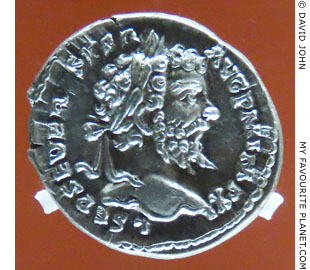
A coin of Emperor Septimius Severus.
Numismatic Museum, Athens. |
| |
| |

The Gorgoneion and aegis in low relief on the cuirass of the gold bust
of Emperor Septimius Severus in Komotini Archaeological Museum.
Medusa's round, baby-faced head is topped with snaky locks and wings.
The heads of two serpents face each other between the wings, their
bodies descend on each side of the head and their tails are knotted
beneath the Gorgoneion's chin. The aegis is repesented as overlapping
rows of feather-shaped scales. |
| |

An inscribed marble stele with a relief as a funerary monument
for the gladiator Lupercus. The bearded gladiator stands fully
armed. In his right hand he holds a sword, and in the left carries
a shield decorated with a Gorgoneion. On the right a boy holds
his helmet, and a small dog leaps up at his left foot.
From Thessaloniki. Around 150-200 AD.
Thessaloniki Archaeological Museum. |
| |
 |
|
 |
A sandstone statue of Minerva (Athena) wearing a plumed helmet
and holding with her left hand a shield decorated with a Gorgoneon.
A copy made in 1900 of a statue from 1683, it stood at the portal between
the larger and smaller courtyards of the royal palace of the kings of Saxony
in Dresden. It is one of a number of damaged and burnt statues that
survived the massive Allied bombing raid on Dresden on 13th February 1945.
Staatshochbauamt, Dresden, Germany. Inv. No. I 4. |
|
| |

19th century iron parade shield with the head of Medusa as the central boss.
Described as "European", the shield was previously believed to have been
made in the Renaissance, but is now thought to be from the 1800s, imitating
the work of the Milanese armourer Filippo Negroli (circa 1510-1579).
Ashmolean Museum, Oxford. Inv. No. WA. OA1447. |
| |
| Medusa |
Notes, references and links |
 |
|
1. Campana plaques
Campana plaques, also known as Campana plates or Campana reliefs, are colourfully painted ceramic reliefs depicting scenes from mythology and daily life, which decorated the interior and exterior walls of sacred, public and private buildings from the mid 1st century BC until the first half of the 2nd century AD. They are named after the Italian art collector Giampietro Campana (1808-1880) who acquired a large collection of ancient Greek and Roman artefacts, and who first published information about the reliefs in 1842.
2. Statuette of a Ptolemaic king as pharaoh in Amsterdam
Marble statuette of a Ptolemaic king as Egyptian pharaoh. From Egypt, findspot unknown.
Height 73 cm, width 21.5 cm, depth 18.5 cm.
Hellenistic Gallery, Allard Pierson Museum, University of Amsterdam. Inv. No. APM 07780.
Acquired in 1921 from the collection of Friedrich Wilhelm von Bissing (1873-1956) by the Museum Scheurleer, The Hague, from which it was obtained by the Allard Pierson Museum in 1934.
See: Branko F. van Oppen de Ruiter, A Ptolemaic king as Egyptian pharaoh. In: Ben van den Bercken (editor), Egyptian Delta Archaeology: Short studies in honour of Willem van Haarlem, pages 113-120. Sidestone Press (sidestone.com), in collaboration with the Allard Pierson Museum, Leiden, 2021. At Academia.edu.
3. The busts of Marcus Aurelius and Lucius Verus from near Marathon
The busts, portraying the co-emperors in very similar cuirasses, were found in 1789 during excavations by Louis-François Sébastien Fauvel on a site at Brexiza, near Marathon, Attica. The bust of Marcus Aurelius is now in the Louvre Museum, Paris (Inv. No. Ma 1161), and that of Lucius Verus is in the Ashmolean Museum, Oxford (Inv. No. AN 1947.277). Also found at the site was a portrait bust of the wealthy Herodes Atticus (Louvre, Inv. No. Ma 1164), a friend and teacher to both emperors, who had a villa near Marathon, where was born and died. The ruins were at first thought to be a tomb, perhaps even that of Herodes Atticus himself, although he is said to have been buried at the Panathenaic Stadium in Athens. It has since been discovered that the site is the Sanctuary of the Egyptian Gods at Brexiza. Another similar bust of Lucius Verus was found in the Sanctuary of Nemesis at Rhamnous (north of Marathon), and is kept at the archaeological site there.
4. Discovery of the golden bust of Septimius Severus
Although the discovery was reported in the press, including The Times of 12th June 1965, and some academic journals, it took a while before further details about the artefact itself were published. The first mentions in print were by the Greek archaeologist Andreas Vavritsas (Ανδρεας Βαβρίτσας):
Α. Βαβρίτσας, Χρονικά, ΑΔ 21, Β2, (1966), page 377.
Α. Βαβρίτσας, Χρυσή προτομή εκ Διδυμοτείχου (Gold protome from Didymoteicho), ΑΑΑ 1, (1968), pages 194-197 (with colour plate).
A. Vavritsas, Eine Goldbüste aus Didymoteichon. In: Actes du premier congrès international des études balkaniques et sud-est européennes. II. Archéologie, Histoire de l’Antiquité, Arts. Sofia 1966, pages 419-422. Sofia, Bulgaria, 1969.
Thereafter there were a few further brief mentions of the bust, but the first "publication proper" (i.e. the first thorough examination, description and evaluation of the bust) was by Anne de Pury-Gysel, former director of the Roman Museum Avenches in Switzerland, where in 2006 she had organized the exhibition Die unglaubliche Entdeckung der Goldbüste von Marc Aurel (The incredible discovery of the gold bust of Marcus Arelius), around the chance unearthing by workmen in 1939 of the now famous gold bust of Emperor Marcus Arelius in an ancient sewer in Avenches (Roman Aventicum).
Anne de Pury-Gysel, Die Goldbüste des Septimius Severus: Gold- und Silberbüsten römischer Kaiser (in German). Librum Publishers & Editors, Basel and Frankfurt, 2017. PDF available at www.edoc.unibas.ch.
A shorter elaboration on the first publication in English: Anne de Pury-Gysel, The gold bust (imago) of Septimius Severus from Didymoteicho (Plotinopolis). In: Journal of Roman Archaeology, Volume 32, pages 313-328. Cambridge University Press, 2019. PDF at journalofromanarchaeology.com.
On the typologies of portraits of Septimius Severus discussed by Pury-Gysel:
Anna Marguerite McCann, The Portraits of Septimius Severus (A.D. 193-211). In: Memoirs of the American Academy in Rome, 30 (1968). Here McCann was the first to correctly identify the bust as a portrait of Septimius Severus.
Dirk Soechting, Die Porträts des Septimius Severus, particularly pages 31-32 and 271. Bonn, 1972.
See also:
Bust of Septimius Severus, a short description at the odysseus.culture.gr website of the Greek Ministry of Culture and Sports.
Dilyana Boteva, Emperor Septimius Severus and his family members visiting the province of Thrace: AD 193-204. In: Maria-Gabriella Parissaki (editor), Aspects of the Roman province of Thrace. Meletimata 69. Thrakika Zetemata II, pages 85-98. Athens, 2013.
Dilyana Boteva, The historical context of the bronze statue of Septimius Severus from the Roman colony of Deultum. In: Archaeologia Bulgarica, Volume XXIV, 2020, 1, pages 23-32. PDF at researchgate.net. |
|
|
| |
Photos on the Medusa pages were taken
during visits to the following museums:
Germany
Berlin, Altes Museum
Berlin, Bode Museum
Berlin, Neues Museum
Dresden, Albertinum, Skulpturensammlung
Dresden, Semperbau, Abgusssammlung
Dresden, Staatliche Kunstsammlungen, Münzkabinett
Hamburg, Museum für Kunst und Gewerbe
Speyer, Historisches Museum der Pfalz
Greece
Abdera Archaeological Museum, Thrace
Athens, Acropolis Museum
Athens, Epigraphical Museum
Athens, Kerameikos Archaeological Museum
Athens, National Archaeological Museum
Athens, Numismatic Museum
Corfu Archaeological Museum
Corfu, archaeological site of the Temple of Artemis
Corfu, Museum of Mon Repos
Corinth Archaeological Museum
Delos Archaeological Museum
Delphi Archaeological Museum
Dion Archaeological Museum, Macedonia
Eleusis Archaeological Museum and site, Attica
Eretria Archaeological Museum, Euboea
Isthmia Archaeological Museum
Kavala Archaeological Museum, Macedonia
Komotini Archaeological Museum, Thrace
Kos Archaeological Museum, Dodecanese
Marathon Archaeological Museum, Attica
Mycenae Archaeological Site and Museum
Mykonos, Aegean Maritime Museum
Mykonos Archaeological Museum
Nafplion Archaeological Museum, Peloponnese
Olympia Archaeological Museum, Peloponnese
Olympia, Museum of the History of the Olympic Games in Antiquity
Patras Archaeological Museum, Peloponnese
Philippi Archaeological Museum
Piraeus Archaeological Museum, Attica
Polygyros Archaeological Museum
Pyrgos Archaeological Museum, Elis
Rhodes Archaeological Museum, Dodecanese
Rhodes, Palace of the Grand Master
Thasos Archaeological Museum, Macedonia
Thebes Archaeological Museum, Boeotia
Thessaloniki Archaeological Museum, Macedonia
Veria Archaeological Museum, Macedonia
Italy
Milan, Civic Archaeological Museum
Naples, National Archaeological Museum
Ostia Archaeological Museum
Paestum, National Archaeological Museum, Campania
Rome, Capitoline Museums, Palazzo dei Conservatori
Rome, National Etruscan Museum, Villa Giulia
Rome, National Museum of Rome, Baths of Diocletian
Rome, National Museum of Rome, Palazzo Massimo
Rome, Villa Farnesina
Italy - Sicily
Agrigento Regional Archaeological Museum
Castelvetrano, Museo Civico
Catania, Museo Civico, Castello Ursino
Gela Regional Archaeological Museum
Palermo, Antonino Salinas Archaeological Museum
Syracuse, Paolo Orsi Regional Archaeological Museum
Netherlands
Amsterdam, Allard Pierson Museum
Leiden, Rijksmuseum van Oudheden
Turkey
Bergama (Pergamon) Archaeological Museum
Didyma archaeological site
Ephesus Archaeological Museum, Selçuk
Ephesus archaeological site
Istanbul Archaeological Museums
Istanbul, Basilica Cistern
Izmir Archaeological Museum
Izmir Museum of History and Art
Manisa Archaeological Museum
United Kingdom
London, British Museum
Oxford, Ashmolean Museum
Many thanks to the staff of these museums,
especially at Dion, Gela, Manisa and Veria. |
|
| Photos and articles © David John, except where otherwise specified. |
 |
Visit the My Favourite Planet Group on Facebook.
Join the group, write a message or comment,
post photos and videos, start a discussion... |
|
|
| |
|
|
| |
| |
 |
| |
 |
| |
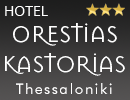 |
| |
 |
| |
 |
| |
 |
| |
George Alvanos
rooms in
Kavala's historic Panagia District
Anthemiou 35,
Kavala, Greece
kavalarooms.gr
|
| |
Olive Garden Restaurant
Kastellorizo,
Greece
+30 22460 49 109
kastellorizo.de
|
| |
Papoutsis
Travel Agency
Kastellorizo,
Greece
+30 22460 49 286
greeklodgings.gr
|
| |
|